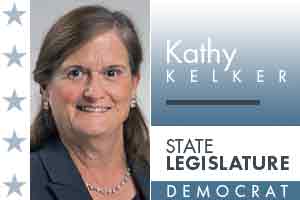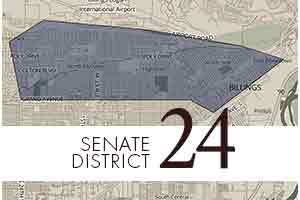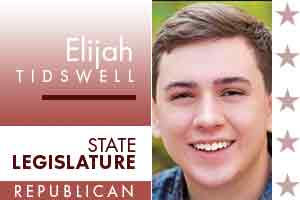State Legislature 2022: Kathy Kelker
One reason that Billings has more than its share of parolees is because Billings has more resources than any other city in Montana. I would like to work with other legislators to figure out a way to have enough treatment centers, pre-lease options and re-entry services in other communities, so that DOC would be able to release inmates in a fair distribution across the state.
Workforce Training–The number of Montana’s working-aged adults is forecast to fall even as the share of Montanans over age 65 rapidly rises. Because of this loss of skilled workers, the Legislature has a crucial role to play in maximizing workforce training and business productivity and educating the next generation to contribute fully to society. Our success will depend in large part on our willingness to favor long-term gain for the whole state over short-term, self-interested expediency. In the near term, Montana needs wider avenues for adult retraining and college degree completion, better coordination between higher education and employers through internships and apprenticeships, and more opportunity for high school students to acquire college-level credits or technical certification while in high school.
Local Option Tax–I have supported local option tax in four of the legislative sessions I have attended. My rationale has been that updated infrastructure and community amenities are vital to growing the local economy. My view is that communities should have the opportunity to present infrastructure projects to their citizens and give them the opportunity to vote up or down on local projects. In the past local option tax has been supported by several cities, the Montana Chamber of Commerce, the Montana Contractors Association along with representatives of architects and engineers. Despite this strong support, local option bills failed because there was opposition from these sources:
- Independent Business of Montana warning that local option taxes could create a patchwork of public policy;
- Utilities (Charter, AT&T, Northwestern Energy) claiming that they should not be taxed;
- Retail businesses objecting to Amazon and other online retailers not having to pay any tax.
For me to support a local option tax, the bill would have to clearly state the following:
- maximum tax rate (3-4 percent)
- mandatory sunset with the possibility of renewal
- limited range of taxable items (consistent with existing Resort Tax)
- specified amount dedicated for property tax relief
- clear definition of “infrastructure”
In addition, the issues of retailer businesses and utilities need to be addressed. I am not as concerned about a patchwork of public policy. To me, this just means local control. Most important to me is solid bi-partisan support for local option tax authority from community leaders and their local legislators.
I strongly believe that the ability to solve local issues should reside at the local level. Municipalities (cities and towns) and counties have granted power; that is, the power given to them by the state can be used at their discretions for specific areas of policymaking. The needs of Montana’s cities, towns and counties vary greatly, so it makes sense to let local governments make decisions that fit their needs and their budgets. Since local government is the closest to the people, it can be the most flexible and responsive to local needs.
In the 2021 Legislative Session, there were some attacks on local government authority; including increment financing, land use and planning authority, gun regulation, inclusionary housing, local option gas tax, and special district financing. Any kind of restrictions on being able to innovate at the local level to address issues ranging from affordable housing to public health to schools are all issues that are best dealt with at the local level.
Billings has more than its share of community supervised convicts. Because our city has many services available for supporting parolees (e.g., substance abuse treatment, pre-release programs, treatment courts, Billings Community Connect), Billings is housing 24% of the statewide total 9,900 community supervised people. I am a member of the Criminal Justice Oversight Council, a bipartisan organization. Membership includes legislators, Department of Corrections leadership, and individuals appointed by the Montana Supreme Court, the Attorney General, and the Governor. This organization is aware that parolees need to be distributed more equitably in all the regions of our state. To distribute parolees fairly, services would need to be increased in other regions of the state. I have been working on this problem and will continue doing so if re-elected.
I am a member of the Local Government Interim Committee. This committee is studying what is needed to create regulations for sober living homes. Currently, our state does not have any regulations, so these homes differ in quality and effectiveness. The committee has studied regulations from other states and will be developing legislation on this topic.
I am also interested on working on reducing caseload standards for probation and parole staff and implementing diversion programs for some offenders. A criminal conviction does not necessarily mean that a person needs to go to prison. In some cases, it makes more sense to divert a convict to a diversion program. Judges make the decision whether a diversion program is appropriate depending on the type of crime and the number of offenses an individual has committed. Diversion programs are designed to help certain offenders overcome their criminal behavior tendencies and drug and/or alcohol addictions. With diversion programs, offenders are given the resources they need to solve their problems and recover from their addictions. Offenders who commit to working hard are highly unlikely to return to their criminal behavior.
Montana ranks among the top 10 states with the largest share of electricity generated from renewables, about 45 percent. Montana’s renewable portfolio standard (enacted in 2005) requires retail electricity suppliers to acquire at least 15 percent of the electricity they sell in-state from renewable energy sources starting in 2015. Montana has consistently surpassed that goal.
Even though Montana has a good start toward reliance on clean energy, there currently is not enough solar and wind electricity to meet the state’s needs. Rather than building power plants, utilities can build better power plans. In those plans, there are four ways that utilities can include solar and wind power while enhancing reliability. When planning for future needs, utilities need to:
- Rate solar and wind properly for peak demands;
- Recognize the contribution of above-average output from solar and wind to reducing power shortage risks;
- Proactively identify needs for upgrades to power lines and other transmission equipment; and
- Recognize the contribution of solar and wind to reducing system wear-and tear.
To rely completely on wind and solar sources, Montana would have to increase the amount of wind, solar and other sources (e.g., hydro) of energy. Also, important would be increasing the wind and solar workforce and developing businesses that manufacture turbine blades and towers would.
Wind and Solar Employment
Montana ranks 5th in the nation for land-based wind potential. When considering the size of its potential wind resource, Montana ranks dead last for creating wind jobs. North Dakota has a smaller wind resource than Montana but has more than 20 times the wind jobs than Montana.
Wind Manufacturing
Montana has no wind-related manufacturing, while North Dakota manufactures wind turbine blades and South Dakota manufactures wind turbine blades and towers.
Montana has two different tax rates on room charges from lodging facilities and campgrounds: a 4% lodging sales tax and a 4% lodging facility use tax. Revenues generated from these taxes provide a substantial amount of funding to the state general fund, as well as many state special revenue funds.
Seventy-five percent of the lodging sales tax revenue is allocated to the state general fund. From the lodging facilities use tax, 25.5% goes to Regional Non-profit Tourism Corporations (local programs). The rest of the lodging facilities use tax goes to state agencies (e.g., Department of Commerce, Fish Wildlife and Parks, Montana Historical Society for Roadside Signs).
Altogether the accommodations taxes provide a relatively small revenue stream directly to local areas. Thirty-five years ago, when the “bed tax” was being considered by the Legislature, there was strong opposition to creating a new tax. At that time, no money at all was set aside for advertising Montana’s tourist attractions. The bill was passed only because several state-level agencies and programs related to tourism would be funded.
I would support an effort to increase the amount of money returned to tourism organizations at the local level but making that happen would have to include a difficult discussion about whether there should be an increase in accommodation taxes to make it possible to send more money back to local organizations.
I have supported local option tax in four legislative sessions. My rationale has been that updated infrastructure and community amenities are vital to growing the local economy. At the state-level, infrastructure projects are prioritized and distributed among many requests. A specific project that is important to one city may not be prioritized in this process. With a local option tax, the voters can support a project that is important to the growth of their community. For me to support a local option tax, the bill would have to clearly state the following:
- maximum tax rate (3-4 percent)
- mandatory sunset with the possibility of renewal
- limited range of taxable items (consistent with existing Resort Tax)
- specified amount dedicated for property tax relief
- clear definition of “infrastructure”
In Montana property taxes are vital for supporting local city and county services and public schools. Residential property owners pay almost half of all property taxes. Every two years, the state reappraises properties and updates property values for the purpose of adjusting property taxes. While property taxes are greater for homes of higher value, the property tax is still regressive because on average households with higher incomes pay a smaller share of their income in property taxes than households living on lower incomes. Low-income homeowners pay a larger percentage of their incomes in property taxes than high-income taxpayers do, because these taxes are based on the value of a home, not on income. In other words, property taxes are disconnected from an owner’s ability to pay.
Montana does need to explore property tax relief for those taxpayers whose income is too low to pay their property taxes. I am interested in a targeted program to reduce property taxes called a “circuit breaker”. This program protects taxpayers from a property tax “overload” just like an electric circuit breaker. When a property tax bill exceeds a certain percentage of a taxpayer’s income, the circuit breaker reduces property taxes to less than the “overload” level.
Circuit breakers are an attractive approach to reduce the property tax because they are better targeted and less costly than “across the board” tax relief mechanisms such as tax caps and homestead exemptions. These credits are a valuable tool for lessening the property tax load on the most vulnerable residents without depleting the state budget.
As I have been canvassing in SD24 in Billings, I have noticed an encouraging trend: older homes, apartments and duplexes built in the 50’s and 60’s are being remodeled and brought up to current codes. In this district, neighborhoods already have mixed housing. Remodeling of these existing properties re-vitalizes the neighborhoods and provides a variety of types of housing at differing levels of cost to the consumers.
The kind of housing improvements in SD24 are driven by federal, private, and local resources and not from programs created by the Legislature. These same sources and others can also be used at the state level. Currently, there are over 23,000 housing units in Montana that support housing affordability. These units are subsidized through several public finance programs that exist in the state for furthering the goal of affordable housing.
- Low Income Housing Tax Credit program as the majority funding source.
- Local public housing authorities
- Seven tribal housing authorities
- The HOME program which is administered by HUD
- USDA 515 subsidies
- Multifamily Coal Trust Homes Program (a Montana program)
Most of these supports for housing subsidies come from federal government programs, often with state match and state participation. The success or failure of these programs depend on how vigorously the state pursues federal grants. Since 2016, Montana has had over 30,000 applications for housing voucher programs, but in that same timeframe only about 4,000 have been issued. Other programs display similar gaps between demand and availability.
The Legislature’s role in housing is in two main areas: land use planning and development and financial aid or incentives for certain types of housing. There is no silver bullet to solve the housing shortage crisis, but here are some strategies that have been successfully in other states:
- Increase the supply of long-term affordable rental housing
- Preserve the physical and financial viability of existing affordable rental housing
- Shore up affordable housing deals in the pipeline
- Revitalize existing neighborhoods
- Use philanthropy and private capital
- Engage business in developing workforce housing
- Offer incentives and tax break
- Increase density
- Repurpose vacant land
- Speed up permitting processes
- Build more tiny homes
- Consider prefab and modular building



